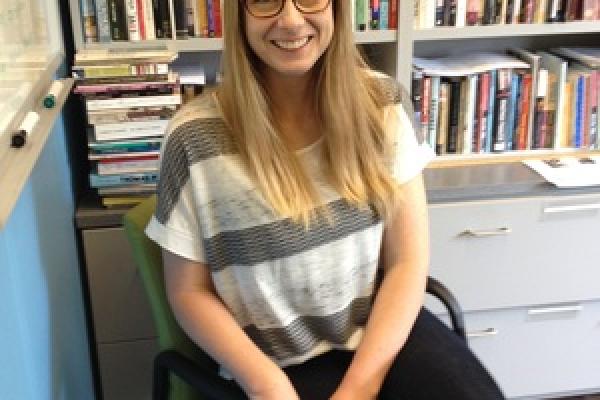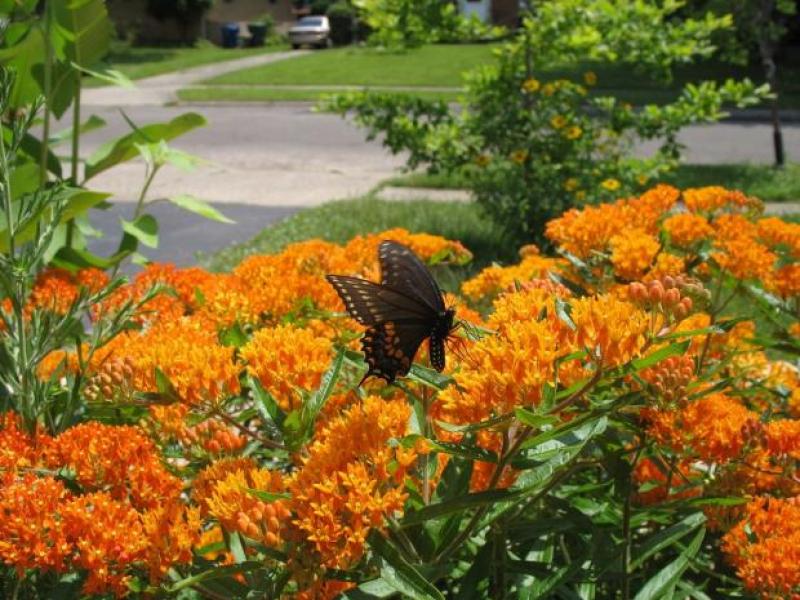October 19, 2018
Obsession Story: Cecilia Johnson and Wildflower Gardening

For this series, we reach out to a member of the department who has a very particular obsession and ask them to share it with the world. In this edition, Undergraduate Academic Advisor Cecilia Johnson cultivates a wilderness wonderland in her own backyard.
Taking a stroll one day, I deviated from my normal route along the bike path and wandered instead into the surrounding neighborhood. I passed tidy houses with geometrically trimmed hedges and squares of neat, clipped lawn. The sidewalk curved, and as I rounded the bend, I came upon a yard so unlike any of the others, I had to stop mid-step. Rather than mowed grass and tamed, shaved hedges, this yard bloomed with rambling plants, overhanging trees, and flowered vines. My eyes caught the flash of movement on the ground—a striped chipmunk hurrying about his business with an acorn in his cheek. Above him, butterflies flitted back and forth, and yellow birds hung upside down from spiky flowers, pulling out seeds and chomping them. Unlike the other yards, there was so much life here—gossamer and feathered wings soaring in and out of view, little furry faces and tiny, running feet. I felt I’d stumbled on a fairytale or Beatrix Potter’s yard or a remnant of Milton’s Eden. What is this place? I asked myself. I bent down to read a sign poking up from amid the flowers—“Certified Wildlife Habitat.”
So that’s how my obsession with wildlife gardening began. When I arrived back at my apartment, a quick search on the Internet for “certified wildlife habitat” brought me to the website for The National Wildlife Foundation where I learned that the four key elements for establishing a wildlife habitat are food, water sources, places for cover and places to raise young. I thought to myself, if I’m ever lucky enough to have access to my own yard, I’m going to create a garden according to these principles.
Flash forward a few years, and my dream for having my own yard came true. Feeling a little overwhelmed, I figured I’d start small with a butterfly garden. This brought me to a book called Butterfly Gardening with Native Plants, Midwest Edition by Christopher Kline. Through Kline’s book, I learned that a successful butterfly garden must have host plants as well as nectar plants. Host plants are those plants upon which butterflies lay their eggs and then support the emerging caterpillars during the caterpillar stage of the lifecycle. Once the caterpillars emerge from their chrysalises as butterflies, nectar plants are those plants with blooming flowers from which butterflies derive their sustenance. I was surprised to learn that a caterpillar can’t eat just any plant but is specialized to only eat certain particular plants with which it shares an evolutionary history. Kline’s book, as well as the National Wildlife Foundation’s website, kept referring to “native plants” as the keystone to supporting the needs of wildlife, and a desire to understand this concept led me to a book by the entomologist Douglas Tallamy called Bringing Nature Home: How You Can Sustain Wildlife with Native Plants. Through Tallamy’s book, I learned about the idea of “food webs” and how energy moves from plants to the insects that eat the plants to the mammals, birds, reptiles and amphibians that eat the insects. Because plants contain all sorts of chemical compounds, insects have had to physiologically adapt in order to be able to digest those compounds and survive. That process of adaptation has taken place over hundreds of thousands of years. During those years, insects adapted to the plants that were around them. “Native plants,” for those of us living in North America, are those plants present in our local ecosystems that were here prior to European colonization when all sorts of new plant species were introduced. Because those introduced plant species don’t share an evolutionary history with the insects in our ecosystems, their use in food webs is very limited. Take the monarch butterfly, for instance. It is evolutionarily adapted to digest the compounds present in milkweed plants—a native plant that used to be present all up and down its migratory path. When large-scale industrial agricultural practices and urban development wiped out significant amounts of the milkweed plants that monarch butterflies depend on, its populations plummeted, and unfortunately continue to do so.
Learning about the importance of native plants in supporting the food web that supports wildlife (and all life) led me to an obsession with putting native plants into my garden. I discovered a national organization devoted to gardening with native plants called Wild Ones and began attending lectures in my community. I learned about Franklin Water and Soil Conservation District’s backyard conservation program and found out that every year they put on a tree and plant sale where I can purchase native plants inexpensively.
The more I learn about wildlife gardening, the more I realize I have to learn. I’m far from an expert, and ten years in, I still consider myself to be a newbie. When I sit out in my garden and a monarch lands on a milkweed plant, or a hummingbird drinks nectar from a cardinal flower, or a yellow finch pulls seeds from an Echinacea plant, or the lightening bugs glow as dusk turns to night, I’m grateful for the happy accident of wandering past an unusual front yard all those years ago. I’m hopeful that as more people learn about the concept of wildlife gardening, the more wildlife gardens and wildlife we’ll see.

By Cecilia Johnson
Obsessed with our Obsession Stories? Check out previous editions:
- Lauren Squires and Tap Dancing
- Karen Winstead and Vampires
- Leslie Lockett and the History of Cheesemaking
- Karen Bruce and Crosswords
- Dorothy Noyes and Opera
